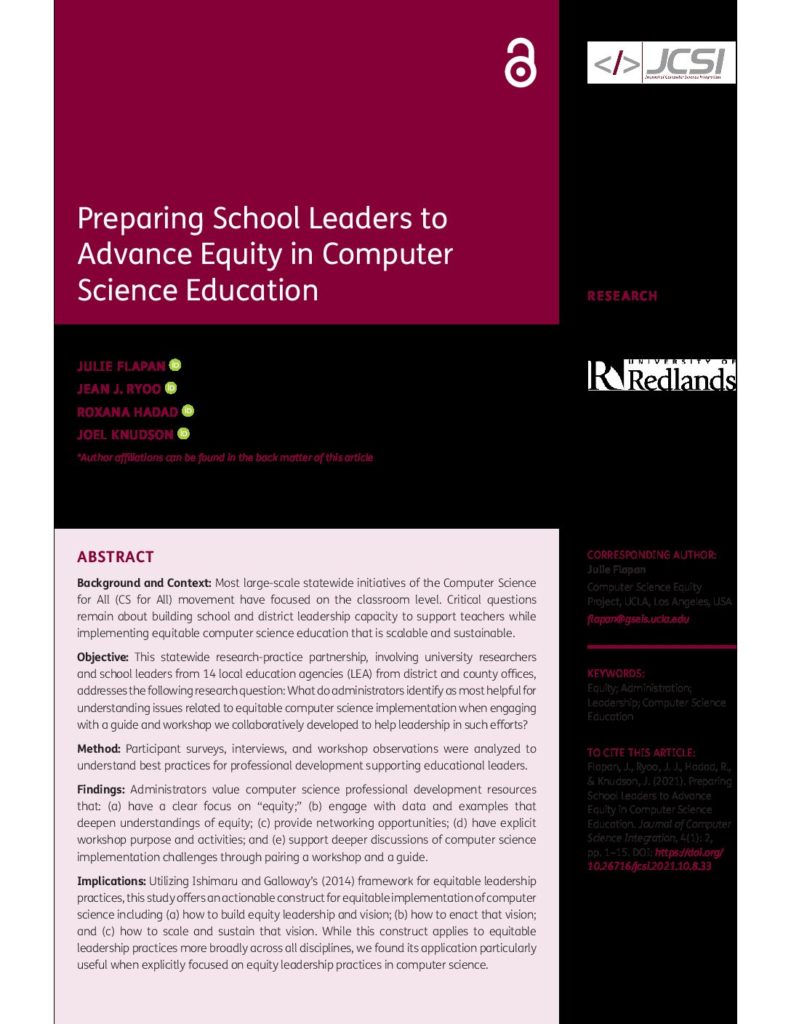Research & Policy
Check out the latest research and policy on computer science education equity in California!
Riverside CS Equity Case Study: Engaging Families & Communities to Support Computer Science
Riverside Unified School District (RUSD) is the 16th largest school district in California, part of the rapidly growing Inland Empire, a large metropolitan area and region in Southern California. This case study explores RUSD efforts to increase student engagement in computer science education by tapping
into the value of parents, families, and external educational partners, typically not involved in CS.
Making Computer Science Count in California
CSforCA believes high quality computer science (CS) education should be available to all students. When computer science “counts” it is recognized as foundational learning, and will be prioritized and supported as a core academic subject. Making computer science count toward high school graduation and college eligibility will create important incentives for young people to take it. We are pleased to share here the many ways to count CS education in California, making it accessible to all students, regardless of their pathway.
LAUSD CS Equity Case Study: The Process and Impacts of a District-Wide Resolution
This case study explores the impact of a school board resolution in the Los Angeles Unified School District (LAUSD) to expand access to Computer Science education for students and professional learning for teachers. LAUSD has done work around increasing computer science education in its district, which
serves predominantly Latinx students.
Santa Barbara County CS Equity Case Study: Professional Learning through Communities of Practice
This case study explores how the Santa Barbara County Education Office (SBCEO) organized a professional learning network to support district leadership to implement the newly adopted Computer Science Standards in an equitable manner
Preparing School Leaders to Advance Equity in Computer Science Education
This statewide research-practice partnership, involving university researchers and school leaders from 14 local education agencies (LEA) from district and county offices, addresses the following research question: What do administrators identify as most helpful for understanding issues related to equitable computer science implementation when engaging with a guide and workshop we collaboratively developed to help leadership in such efforts?
California Computer Science Access Report
This report examines
the landscape of computer science education across the state of California, and examines who has access, who participates, and where equity gaps by race, gender, income, and geography continue to persist. Findings indicate that, while some progress has been made in expanding access to computer science education, much work remains to increase equity in access and enrollment, particularly among Black, Indigenous, Latinx students, girls, low-income students, and rural students.
AIR California Computer Science Policy Report
This report can inform the ongoing work of CSforCA and its partners by describing developments in CS Education in California over the past decade. The American Institutes for Research interviewed 20 stakeholders closely involved with policy developments in Sacramento.
Advancing Equity in CS Education for California
A two-page snapshot on CSforCA - why equitable computer science education in California is worth fighting for, our solutions to build the right infrastructure across the state, and how you can get involved.
What is Computational Thinking and what Does it Have to do with K-12 Education?
Computational Thinking (CT) is a key component of Computer Science (CS), and CS education. This two-page guide explains how CT helps build skills related to critical thinking and problem solving, as well as advancing equity and social justice.
Computer Science Education Data: Centering Equity to Measure What Matters
Computer science (CS) education has the power to shape the futures of California’s students, our economy, as well as our society at large. However, systemic and historic inequities embedded within our education system impact the patterns of who participates in CS education.
In order to ensure equitable CS education, an intentional focus on equity must be embedded in data collection, analysis, and decision-making and inform the work of educators, district administrators, and policymakers.
CSforCA Policy Agenda
Download this graphic of CSforCA’s 4 policy priorities for 2019-20. These priorities will ensure equity and access to high quality teaching and learning opportunities in computer since in California.
California Computer Science Strategic Implementation Plan Report
The California Computer Science Strategic Implementation Plan provides recommendations for supporting K–12 computer science education. This report suggests the best practices for California and its local education agencies to improve CS education through expanding CS course offerings, increasing CS educators, and implementing equitable strategies by expanding CS opportunities.
CS K-12 Standards
The California Computer Science K-12 standards is a detailed breakdown of the standards the California Department of Education set to ensure students receive quality computer science instruction. Designed to inform teachers, curriculum developers, and educational leaders to ensure all students receive a quality computer science education, these standards set the learning goals for students in regards to what they should know and be able to do with computer science at the K-12 grade level.
For an interactive version of the standards, where you can filter by grade level and concept, visit the K-12 Computer Science Content Standards site.
Teaching CS: Meeting the Demand in CA Infographic
Discerning between who can and can’t teach computer science in California is confusing. This infographic delves into who can teach computer science, and what the varying credentials enable teachers to do.
CS Professional Development Week Infographic
Summer of CS is a week of professional learning we held for over 200 computer science educators, counselors, administrators, and policymakers. Here's an infographic of the model we used, and how it can be adapted on a regional basis. It also shows the need for professional development in building equitable, scalable and sustainable CS education.
What is SCALE-CA? Infographic
Supporting Computing Access, Leadership and Equity in California, or SCALE-CA, is a research practice partnership that works to ensure equity is at the core of CS in CA. This infographic outlines the guiding principles that are key to the partnership.
















